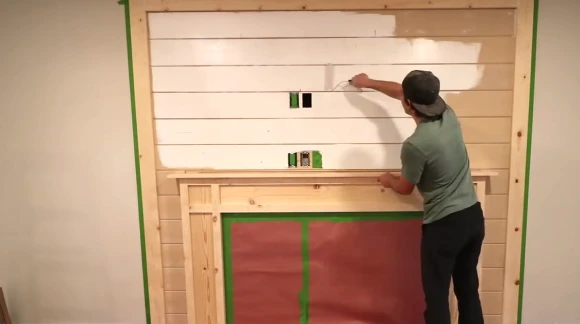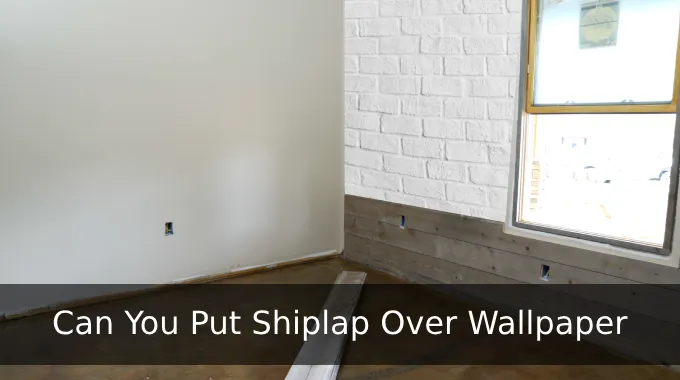Last Updated on September 16, 2023
Shiplap is a beloved design trend that has swept through countless homes, imparting a timeless rustic charm to interiors and exteriors alike. But before you embark on your shiplap renovation journey, a critical question deserves your attention: Is shiplap fire-resistant?
Some modern shiplap versions use fire-resistant materials, such as fiber cement, inorganic minerals, or flame-retardant additives. These fire-resistant shiplap options are engineered to reduce the risk of ignition and slow the spread of flames.
But traditional wooden shiplap isn’t inherently fire-resistant by nature. A primary component of standard shiplap is wood, which is a combustible material that can catch fire when exposed to high temperatures or flames.
However, there are variations and treatments available that can enhance the fire resistance of shiplap. We will discuss how to determine if the shiplap is fire-rated and how to install the shiplap around your fireplace.
Is Shiplap Fire Resistant: A Guide for Identifying

To determine if shiplap is fire-rated or has fire-resistant properties, you can follow these steps:
- Check product information
- Ask the supplier
- Look for fire-resistant materials
- Research independent certifications
Let’s examine each aspect in detail to determine whether shiplap is fire resistant.
1. Check Product Information
To find out if the shiplap is fire resistant, check the product information and specifications provided by the manufacturer.
Look for any details regarding fire resistance, flame spread ratings, or compliance with fire safety standards.
Fire-rated shiplap will typically come with documentation that clearly specifies its fire-resistant properties.
Pay close attention to any certifications or testing standards mentioned in the product information. The details can provide valuable insight into the shiplap’s ability to withstand fire.
Additionally, take note of any specific installation requirements or recommendations related to fire safety measures.
2. Ask the Supplier
If you’re purchasing shiplap, ask the supplier for specifics on how well the product can withstand flames and what kind of fire rating it has been given. Inquire about any tests or certifications conducted to determine its fire resistance.
Also, ask if any special precautions or maintenance requirements are needed to maintain its fire-resistant properties.
3. Look For Fire-Resistant Materials
Make sure you check for materials that have better fire resistance when searching for a fire-rated shiplap. Fire-rated shiplap is often made from materials like fiber cement, which inherently have better fire resistance.
Fiber cement is composed of a mixture of cellulose fibers, sand, and cement, making it highly durable and resistant to flames.
In addition to its natural fire-resistant properties, fire-rated shiplap may contain additives or treatments that enhance its ability to withstand fires. These additives can include flame retardants or chemical coatings that create a barrier against heat and flames.
4. Research Independent Certifications
Look for certifications from recognized testing agencies, such as Underwriters Laboratories (UL), to ensure the fire-rated shiplap has undergone independent testing. These certifications provide valuable reassurance that experts in the field have thoroughly evaluated the product’s fire resistance.
When a shiplap product receives a certification from a reputable organization like UL, it meets specific fire resistance criteria and standards.
How Can You Install Shiplap on the Wall Around Your Fireplace: Step-By-Step

To install the shiplap around the fireplace, you will need to follow the below steps:
Step 1: Gather the Necessary Supplies
Before starting the installation process, you need to gather the necessary supplies. Get shiplap boards, a heat-resistant pad, a level, a measuring tape, a marker, nails or screws.
Also, collect a caulk and caulking gun, a saw, and safety gear including goggles and gloves.
Step 2: Prepare the Wall
To ensure that the shiplap adheres properly, you must thoroughly clean the wall surface to ensure that it adheres properly. Remove any debris, dust, or loose paint.
If you have an existing finish, it’s advisable to sand it lightly to improve adhesion. Cleanliness and an even wall are essential to create a smooth shiplap effect.
Step 3: Cut Both the Heat-Resistant Pad and Shiplap Boards
Now, cutting the heat-resistant pad and the shiplap boards is necessary. Before cutting the shiplap boards, measure the area where the heat-resistant pad will be placed directly behind where the shiplap will go.
Cut the heat-resistant pad to size using a saw. Ensure it covers the entire area behind the shiplap.
Make precise measurements using a measuring tape to cut the shiplap boards accurately. If you have corners or obstacles like a mantel, use a miter saw to make accurate cuts.
Step 4: Install the Heat-Resistant Pad
After cutting to size, place the heat-resistant pad on the wall behind where the shiplap will be installed. Ensure it’s flush against the wall and covers the entire area exposed to heat from the fireplace.
Secure the heat-resistant pad to the wall using appropriate hardware, ensuring it’s firmly in place. This pad acts as a barrier between the fireplace’s heat and the shiplap to prevent damage.
Step 5: Begin Installing Shiplap
Once the heat-resistant pad is securely fastened to the wall, you need to add the shiplap from the bottom of the wall and work your way upwards.
Apply liquid nails or adhesive to the back of the first shiplap board, concentrating the adhesive between studs for maximum support.
Use a level to position the first shiplap board straight and even on the wall. Secure it to the wall with nails or screws, ensuring the fasteners penetrate the wall studs for stability.
Continue adding shiplap boards one by one, securing them to the wall with adhesive and fasteners, ensuring they interlock correctly for the shiplap effect.
Once installed, caulk around unsealed touching points and seams for a professional, finished look while also preventing any drafts. Finish by sanding any rough edges and apply paint or stain if desired.
Does painting shiplap make it fire-resistant?

Painting shiplap does not make it inherently fire-resistant. While paint can provide a degree of protection against flames, it doesn’t transform shiplap into a fire-resistant material.
Shiplap, typically made of wood, remains susceptible to burning at high temperatures or in the presence of flames.
To enhance its fire resistance, you would need to explore alternative materials such as fire-resistant shiplap versions made from non-combustible materials like fiber cement, ceramics, or steel.
Keep Your Home Safe With Modern Fire Resistance Shiplap
It is now clear whether shiplap is fire-resistant; the answer lies in understanding the materials and treatments used.
Traditional wooden shiplap, in its natural state, is not fire-resistant due to wood’s combustible nature. However, modern fire-resistant shiplap options, typically made of fiber cement, are available, which possess better fire resistance.
It’s crucial to check product information, ask suppliers about fire ratings, look for fire-resistant materials, and research independent certifications when determining the fire resistance of shiplap.
Keep in mind that painting shiplap won’t make it fire-resistant; you’ll need to choose the right materials for the job. Prioritize home safety using shiplap near heat sources like fireplaces.



